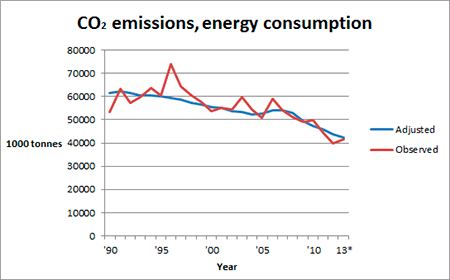Press Release
Although Eurostat figures showed an increase in carbon emissions for last year, this is only because Denmark imported less electricity from neighbouring countries in 2013 than in 2012. Adjusted for the trade in electricity, carbon emissions actually fell by 3.5% in 2013.
Yesterday, Eurostat’s statistical office issued figures showing carbon emissions from EU Member States in 2013. The figures showed that Danish emissions rose by 6.8% compared with 2012 - the highest increase among all 28 Member States. The figures have sowed doubt about whether Denmark is still heading towards a drop in carbon emissions.
However, the large increase is only due to the fact that Danish imports of electricity from neighbouring countries fell drastically in 2013 compared with 2012, when net imports of electricity were high. This led to an increase in coal consumption by Danish power plants of 26.3% and therefore an increase in carbon emissions.
There can be large fluctuations from year to year in how much electricity Denmark imports and exports from e.g. Norway and Sweden. Among other things, this depends on the rainfall in these countries. In years with little rain, electricity prices will increase on the Nordic electricity market, and Danish power plants will therefore cover a greater part of the electricity consumption. The situation reverses in years with much precipitation. In this situation production by hydropower plants will increase and therefore the coal consumption in Denmark will fall. Therefore in 2012, coal consumption fell by about 22% and observed carbon emissions by 10.3% compared with 2011.
For a more fair presentation of developments in Denmark, adjustments can be made for carbon emissions linked to the production of electricity traded with countries outside Denmark, and for fluctuations in energy consumption for heating as a result of cold and warm years. When adjusted, figures from the Danish Energy Agency show that carbon emissions fell by 3.5% in 2013, and thus are continuing the same trend as has prevailed for many years, cf. the figure below.

Denmark’s observed carbon emissions from energy consumption have dropped by 11.7 million tonnes since 1990, corresponding to 22%. After eliminating the effects of electricity trade and fluctuations in climate, carbon emissions have been reduced by 31% since 1990. It should also be noted that the part of carbon emissions which fluctuates most from year to year has been regulated by the emission trading system, so an increase in Danish emissions is counterbalanced by a reduction in emissions from other countries and vice versa.
The Danish Energy Agency’s calculation method deviates from Eurostat’s calculation method of carbon emissions for energy products. The most important differences are in the treatment of figures for international air travel, the choice of emission factors and the method for calculating developments in carbon emissions. In both calculation methods, the calculation is based on preliminary figures, and this is why the figures are associated with some uncertainty.
Ture Falbe-Hansen
Pressechef
Center for Organisation
Tlf.: 25 13 78 46
tfh@ens.dk
Mikkel Sørensen
Kontorchef
Center for Klima og Energiøkonomi
Tlf.: 33 92 67 26
mis@ens.dk
